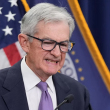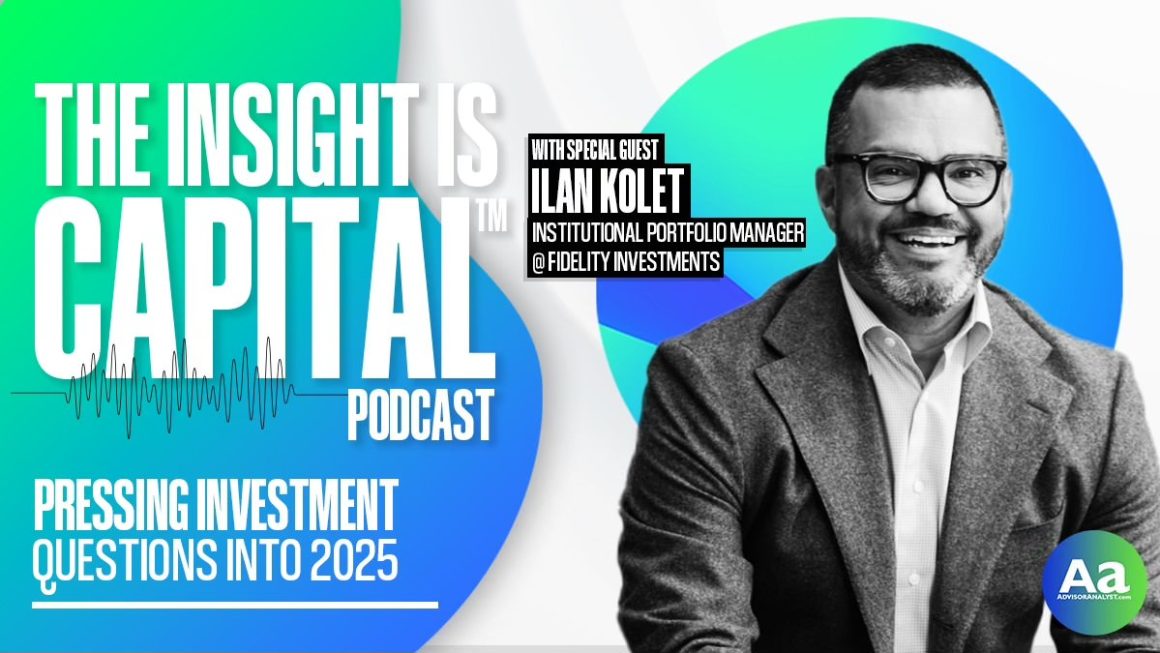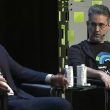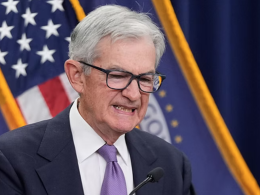Pierre Daillie: [00:00:00] Welcome back. I’m Pierre Daillie, Managing Editor at AdvisorAnalyst.Com. And this is Insight is Capital. Ilan Kolet, Institutional Portfolio Manager in Fidelity’s Global Asset Allocation team is here to talk about the questions he and his colleagues have been fielding most frequently from advisors and investors at the start of 2025.
This is the Insight is Capital podcast.
Announcement / Disclaimer: The views and opinions expressed in this broadcast are those of the individual guests and do not necessarily reflect the official policy or position of advisoranalyst. com or of our guests. This broadcast is meant to be for informational purposes only. Nothing discussed in this broadcast is intended to be considered as advice.
Pierre Daillie: Ilan, welcome back. Happy New Year. Uh, is it too late to wish you a Happy New Year on January 24th?
Ilan Kolet: Well, I don’t know. I mean, I think Larry David would probably say it’s, uh, it’s too late for us to be wishing each other, uh, Happy New Year. But no, Happy New Year, Pierre. It’s great to see you. I always like our discussions and, um, it’s great that we’re kicking off the [00:01:00] year, I mean.
Even though this year, this month already feels like we’re halfway into the year, but, uh, excited to have the chat today.
Pierre Daillie: Yeah, likewise. It’s great to have you. It’s been a relatively short while since we last spoke. It feels like we just spoke, but then, you know, in the meantime, so much has happened. The outcome of the election, we’ve got a new U.S. President. The resignation of our own PM here in Canada. So there’s definitely a lot of political slash policy uncertainty on either side of the border. Uh, so obviously some of it’s positive, some of it’s negative, but we had, uh, chair Powell’s December 18th pivot. Uh, in spite of that, stocks are testing new all time highs with some improvement in breadth.
U.S. Treasury yields tested new highs, uh, which has been really hard on any sort of duration bond investments for, for, uh, you know, in the treasury side and even Canada 10 year yields have been testing 3. 5 [00:02:00] since they bottomed last fall with a high two handle. Um, and kudos to you because the last time we spoke, one thing you did say that was.
that, you know, I sort of, um, flinched a little bit was that the Canadian dollar has done exactly what you said it would. There is a six after all, uh, in the exchange rate. The stock market, however, doesn’t seem to care about what the bond market is telegraphing. Uh, neither do gold or Bitcoin. What do you make of all this?
Ilan Kolet: Yeah. I mean, it’s really been, um, It’s sort of remarkable. There’s a lot of things for us to unpack, right? I mean, it’s not normal for a balanced fund or a balanced solution to return almost 20 percent in a year. Right. Um, you know, it’s, it’s actually, it’s pretty unbelievable. Um, and we’re, you know, I’m certain we’ll talk about valuations and stuff, but honestly, PR, I think the.
The best place for us to start is the question that I have been getting dozens of times a day, which [00:03:00] is around political instability, political uncertainty, tariffs, trade. Um, I think it makes sense for us to hit that right at the start because, you know, um, uh, We have a lot of other thoughts. I mean, again, we’re optimistic.
We’re overweight U.S. Equities. Um, we have specific positions on the fixed income side as well, but the place I think for us to start is really political uncertainty, um, and tariffs. And yeah, that’s, that’s the, that’s the elephant in the room, right? That’s the, exactly, exactly. And again, I mean, this is, um, you know, this is.
I spent all of last week in B. C. and I tried to hit on this right at the start, knowing full well people will probably remember what I say at the beginning and maybe at the end and might remember and might forget everything in between. So, I mean, in thinking about tariffs, um, You know, I spent almost 10 years at the Bank of Canada and if I was sitting at the Bank of Canada today, the way that I would try to interpret, [00:04:00] uh, proposed tariffs is we’d have to make three assumptions, right?
And those assumptions would be how big are the tariffs, right? Is it 25 percent or is it zero? And this is just a negotiation tactic. So that’s the first question. The second question we would have to think about is, uh, what is the list of items that will be on the tariff list, right? Is this every single thing that Canada exports or is it, I don’t know, frozen French fries?
So you eat 97 percent of US frozen French fries that are consumed come from Canada. Fun fact. And then the third one is how long do these last, right? And so those assumptions based around, um, those three things would give you something Uh, that sort of represents, um, a magnitude and even that is an estimate.
So again, there’s not a tremendous amount of uncertainty. There’s actually a lack, a complete lack of certainty, right, is the way that I would, I would sort of phrase it [00:05:00] and, and we’ll get to the estimate in a second, but let’s put. Let’s put Canadian exports in perspective. Um, a third of Canadian GDP, roughly 30 percent of Canadian GDP are exports, right?
That’s enormous to put that in perspective. Housing is, you know, 10, 11 percent and think about how important housing has been, but exports account for almost a third of Canadian GDP. And 75 percent of those exports go to the US, right? And so this is. Exports to the U.S. Are a really critical and important driver of Canadian growth.
Um, I mean, we haven’t had much of that growth, but Canadian growth. The buckets that we export in terms of like what the shares are, about a quarter of the exports from Canada are Energy, energy products, crude oil, essentially. Uh, 14 percent are consumer products. I can include some of that food. Um, 10 percent are related to autos.
And then there’s another big bucket related to this, call it other commodities or other things that we dig out of the ground. On the [00:06:00] U S side, thinking about. What are the important imports from Canada in terms of their shares, you know, U S U S consumes about 20 million barrels a day of oil, about 40 percent of that oil is imported and about 60 percent of those imports come from Canada.
So, right. Uh, U.S. Oil imports from Canada account for, I don’t know, call it 12 or 15 percent of overall U.S. Oil consumption. Right. So that it’s a bit of an oversimplification, but it helps to sort of set the stage in terms of what’s important in terms of the shares, both for Canada and for the U.S. And so it’s a, it’s a very, very long lasting, um, you know, bilateral trade.
Uh, it’s very, very strong between the two countries and, and critical. Really for both countries in different ways. Now, in terms of assessing the magnitude of a tariff shock and what it would mean. Um, it’s really remarkable. So in 2019, the bank of Canada in its April monetary policy report on page. The [00:07:00] 24 of the PDF, if folks want to check it out, the bank of Canada in box two of their NPR did a simulation with the full strength and scope of their models, which take into account all of the secondary channels and retaliatory tariffs and everything.
I mean, really they’re full blown models. Right. Um, they tried to estimate the impact of a 25%. Import tariff on, on all goods. And there’s three numbers to remember. And I’m pretty sure these will be the three scariest numbers we talk about on today’s podcast. A 25 percent tariff on anything imported into the U.S exported, say from Canada, would result in a 6 percent decline in Canadian GDP. Okay. That’s. Enormous to put that in perspective. Yeah. So to put that in perspective, 6 percent decline in GDP is larger than the decline in GDP in the financial crisis, larger than the decline in GDP in the nineties recession or in the [00:08:00] eighties recession, right?
Um, In, in COVID Canadian GDP fell by about 12%. So it’s about half as big as that. I don’t use COVID as an example, cause it was such a weird shock. And everyone, most people kind of remained employed, um, or at least got some income support, um, but it’s a very, very big shock to shock to Canadian GDP. That’s the first scary number, 6%.
The next scary number is a 3 percent upward shock to inflation, right? Not three bps 3%. 300 points. Upward shock to inflation. So 3 percent upward shock to inflation. And of course that’s coming because. Of the depreciation in the Canadian dollar, which would make those imports more expensive as well as, uh, you know, some retaliatory stuff.
And then, and then the third one is a 25 percent depreciation of the Canadian dollar. So Pierre, from where we are today, that takes the Canadian dollar to 52, 53 cents. So again, 6% negative shock to GDP, [00:09:00] 3 percent positive shock to inflation, but I’m not sure you can call that positive, but upward shock and a 25 percent depreciation, further depreciation of the Canadian dollar.
Right. So again, what I, what I try to do is, um, in my conversations around tariffs, I have to provide something between absolutely no answer and complete uncertainty and an overconfidence in what I think will happen. And I think. I think sort of discussing the size and scope of the relationship and then layering on this Bank of Canada simulation is one way to get at it.
I mean, the bottom line here is we should be taking, uh, the threat of tariffs exceptionally seriously. It’s not really the time for us to have sort of this political vacuum that we, that we’re witnessing right now in Canada. Um, because it would be exceptionally damaging, um, to Canadians. In terms of growth, inflation, employment, um, and the value of the Canadian dollar.
A lot more staycations, I can tell you that if that happens.
Pierre Daillie: Wow, [00:10:00] that’s, uh, that’s eye opening, Ilan. I mean, I think, I think everybody is in the camp of, you know, concerned or worried, but probably not to the extent that, that that scenario, uh, demands.
Ilan Kolet: Yeah, no, I mean, it’s, uh, again, it’s a, it’s a really incredible, um, uh, sort of, and it’s a very, very short little analysis that they’ve done.
And again, I know exactly how they would have done that. They would have, you know, they run these sort of base case scenarios and they would have run a risk analysis, again, using their, their large models that are fully specified. Really, really powerful tools, um, run by really smart folks and, and to come up with this, with the simulation.
Now, I, again, I would consider that this is sort of the downside, the most negative type of scenario. There’s a possibility that all of this is, you know, a bit of a, a bit of a, a bit of the art of the deal or, or, um, you know, or, or exactly. And, but even then, [00:11:00] Pierre, what I would caution is. I mean, the threat of tariffs, that cloud, um, is also still damaging, right?
So
Pierre Daillie: again, Yeah, just a threat. Just the idea that it could happen is putting a crimp in activity. Exactly. And,
Ilan Kolet: and
Pierre Daillie: so,
Ilan Kolet: you know, if businesses like certainty or they value certainty, right? They don’t like uncertainty. And so does, so do consumers. You know, if I, if I was a Canadian business owner and I was thinking about expanding my operations and this cloud of tariffs, even as uncertain as it is, was, was overhead, you might pump the brakes or you might kick the can.
Right. And, um, in fact, in the most recent CFI, CFIB survey, that’s Canadian Federation of Independent Business, they ask a question related to this, um, and sure enough, they’re. I mean, it’s only one data point, but it does look like there is some hesitation there. Um, and that’s, again, that’s something that we’re monitoring because, effectively, Canadian economy has not grown that much at all since the start of [00:12:00] 2023.
Um, you know, we need all the engines and growth that we, that we can get at this point. Um, so. Now, is that,
Pierre Daillie: Ilan, is that, is that, yeah, no, definitely, tariffs will not help. Um, is that. Uh, if that scenario was to play out or some amount of that scenario, some, some, some degree of that, um, is that net inflationary or is that net deflationary?
Like if there’s an economic shock that comes as a result of, of, of a drop in GDP of 6%, which is half as bad as what happened during COVID. Uh, and, and worse than, than, uh, previous economic shocks, um, does that end up being a net deflationary issue or, or net inflationary? Like prices go up, but, but, you know, that means that the bank of Canada is going to have to get very [00:13:00] active to stimulate the economy under the circumstances, right?
I mean, you know,
Ilan Kolet: so I would say the inflation part of the analysis is one in which there’s There’s a few ways to look at it and it’s not a clean cut answer, right? So the shock to prices, I mean, one way that comes through is a 25 percent depreciation of the Canadian dollar makes Every single thing that’s on the shelf at the big, at the big box store, much more expensive, but if it’s a one time price, if it’s a depreciation, unless, you know, suppose the Canadian dollar depreciates in one shot very quickly, then that’s a one time price level shift in all of those products.
Right. Um, and that is a change in the price level. You could imagine it as a change in the price level, and then the inflation rate kind of continues as is. I think. Um, the effect that it would have on the real economy and employment would be, and those effects would be far more impactful [00:14:00] from a deflationary perspective than the long term inflation impacts.
Again, I mean, this is, and there are people who will have different views here, but I think the demand shock. Will actually, um, hurt from a, from a disinflationary or deflationary perspective much more than the one time price level shock that might come from those imports being, being more expensive. You know, Pierre, in, uh, and again, it’s also, this is also damaging for American households.
Right? So. Right. Yeah. It’s mutually damaging. Yeah. Exactly. This is a mutually damaging, uh, shock. There’s a, there’s a really great, well, great is the wrong word, but there’s a good case study again for this. So there’s a good case study again for this. Um, In 2018, I was living in the U S you know, I was on the asset allocation research team down in Boston and this was during Trump one, 1.
0 and Trump levied a 20 percent import tariff on [00:15:00] imported washing machines. Okay. And right. Um, again, most of us probably forget that, but I was the inflation analyst at the time and, and I saw this happen. And so he imported the, I mean, he imposed this 20 percent tariff on imported washing machines. A huge portion of washing machines are imported, right?
And not a lot are built in the U.S. And within the inflation data, so within the CPI and the PCE data, you actually get a full disaggregation between goods and services. And in, and if you click into goods, you get, um, major household appliances. And if you click into major household appliances, you get washer and drying, washing and drying machines.
They don’t call them washers and dryers. I don’t know why, but they call them washing and drying machines. Um, uh, and. If you look at that line item in the inflation data, the line item for washing and drying machines rose 19. 9 percent in the months following the 20 percent import tariff, right? [00:16:00] I say, it wasn’t passed on dollar for dollar, it was passed on penny for penny, right?
It was passed on penny for penny, but the way it showed up was a one time increase in the price level, and then the inflation rate that preceded it kind of continued. And interestingly,
Pierre Daillie: That’s the thing, right? I mean, the inflation rate is the, is the ongoing sort of Delta, right? It’s the ongoing change in prices.
It’s not the one time shock. Oh, prices went up 10%. It’s it’s prices went up 10 percent plus an additional 3 percent a year. Exactly. An additional 5 percent a year. Yeah,
Ilan Kolet: that’s exactly right. And I think. I mean, I think the folks, you know, in our community, we sort of understand that the inflation rate is the price today, the price 12 months ago.
And the change between that is the inflation rate, which is very different than, than imposing a 20%, um, price level shock, which is massively inflationary in one, in, in one month [00:17:00] or two months, let’s say if it’s split between a couple of months and then it falls out of the data kind of 11 months later. I mean, everyone is worse off because of that shock.
But It’s not a generalized, uh, it doesn’t show up as generalized inflation. The one thing I would caution there is, uh, and this is really hard. As an economist or analyst to think about, but if there is, you know, a 25 percent tariff on these goods in this month, and then a few months later on these goods, and then a few months later on these goods, that can look like generalized inflation, because it’s much harder to disaggregate.
So, um, again, I, yeah, I think, I think we should be taking this really seriously and, um, and, and I certainly hope we are.
Pierre Daillie: So, um, before we move on, because I, I want to get to the portfolio discussion as well to, to talk about that, but I’m just curious, like, you know, under an inflationary threat, is there, are you seeing any sort of high [00:18:00] frequency data that says people are acting on FOMO?
You know, to, to, to buy things before something like a tariff comes into play. Uh, like on the other side, if we were facing a deflationary situation, people would just wait for prices to fall and consumption would, would crater a little bit under that circumstance. But in the opposite circumstance, which is under inflation and the threat of rising prices, are people acting on this or are they waiting?
Are they taking a wait and see approach or? Yes. You don’t want to, you know, you don’t want to wait till February 1st and then there’s an announcement. And all of a sudden the price of a car goes up by 15 or 20%.
Ilan Kolet: No, you’re, you’re absolutely right. And actually, I think, I think that question really speaks to an incredible advantage we have at a firm like Fidelity, right?
So, and this is a bit humbling as an, uh, as an, as a trained economist for me to even say, but what I’ve realized is what companies. Our saying and doing today shows up six or eight weeks later in the economic data, right? So [00:19:00] again, I love the economic data. I followed it closely for, I don’t know, almost 25 years, but it’s too late, right?
So we cannot wait for the retail sales data that might come out, you know, for January to in the middle or the end of February for us to, for us to take into account. Some of this, um, sort of pre buy or cautionary CapEx or anything like that. For us, the way that we would get at that, at this data, and this came up in a call yesterday, in fact.
Um, is, you know, we speak to the underlying managers in our strategies really often, and we listen to and consume the equity and the credit research that they’re getting as well from the, you know, hundreds of analysts spread across the globe that Fidelity has. And sure enough, this has actually started to come up in some meetings.
It’s hard for me to discuss some of the details of that, but this is a great example, Pierre, of where, for us, You know, we have this four pillar investment process [00:20:00] that’s macro bottom up sentiment and valuation and that bottom up pillar that speaks to us again, consuming that underlying information. And this is where it’s really, really helpful.
Like similarly, right? So you mean coming out of the pandemic, right? Remember that? I mean, so coming out of COVID, uh, so coming out of COVID. You know, we were unsure about the strength of the recovery. Is this going to be a V, a W? I mean, we had every letter under the sun. And one of the ways that we were able to lean in to a really strong recovery, a V shaped recovery, was the information we were getting from those, um, underlying equity analysts.
So you can imagine like the analysts, again, I heard from them this morning, on the consumer side, on the housing side, right? These, they play a really, really critical role. In helping us form our view about, um, about what it’s going to look like.
Pierre Daillie: So that’s a great segue to talk about portfolio [00:21:00] construction in the global asset allocation mandates that you oversee.
I’m just curious, like, like how do you, like, you know, the whole point of portfolio construction should be to prepare your portfolio for all outcomes, not just one vector. That you might be betting on, but what are all the possible, what could go wrong questions, right? And, and so seeing as this is, you know, a couple, a week, potentially a week away from now, um, how do you prepare for something like that?
How do you, how do you position the, your mandates in case that
Ilan Kolet: shock comes true? Yeah. I mean, again, this is, um, I think a lot of people think. You know, portfolio management is a highly, only a highly quantitative field. And it certainly is very quantitative. There is an entire other element, right? Like there’s the science part, but [00:22:00] then there’s also the art part.
And I hate to use that phrase art because it probably like, uh, over, you know, diminishes actual art. But anyway, you know, there’s like a science and the art. But, but, but,
Pierre Daillie: but it, it, it is a, uh, it is a skill. That is born from compounded knowledge, right? Well, exactly.
Ilan Kolet: And it’s hard and it’s not just purely mechanical or quantitative.
Pierre Daillie: And, and so there’s a liberal, I mean, it’s a liberal art. You can easily say it like economics investing, uh, is a liberal art as well. Right. Exactly.
Ilan Kolet: Or certainly a large, you know, an important chunk of it. And I think about, so I think about this and along the line, along two different lines. The first is, you know, Our goal in constructing portfolios is to choose managers of different styles, sectors, asset classes that follow their own process, that are incentivized to beat their own benchmark, um, and then leave them alone.
Right? So we want, we want to, we want to combine [00:23:00] managers and they’re, again, they’re incentivized to beat their own benchmark. If they beat their benchmark using their process and we own them. They boost the, the, the value and return of our portfolio, and we want to combine managers in such a way to, you know, not have a significant amount of overlap, for example, and, uh, improve the risk, the expected risk adjusted return, right?
So anytime we’re thinking about adding or removing a manager or even adding or removing an asset class, the way that we think about that is in the context of risk adjusted return, right? Um, Um, you know, so we’ll, we’ll never, we never really want to have a huge say growth bias or value bias because we don’t want to be whipsawed by the style that might be in favor, you know, that day, week, month, however it may be.
Um, and then, and then the, the other point is, um, uh, there’s two more points. The other point is, and I think this kind of shows up here for us in [00:24:00] terms of obviously the one year performance, but the one. 3, 5, 7, and 10, right? So again, I think what, what that speaks to, um, is. This consistency of approach of combining fantastic best in class managers and then overlaying that, um, that asset allocation approach of leading in or out of asset classes, style sectors, or geographies, that’s really been, those have really been the two ingredients for success, right?
So if you look at. You know, over the last, since these portfolios became, um, tactical in 2013, if you look at a 60 40 portfolio and you look at the actual experience of the global balance managed portfolio, the wedge at the end of those two of that period, the wedge at the end, the end of that period of those two lines is 40%, right?
And so the 40 percent excess, um, return with some of that with about 25 percent of that coming from the underlying [00:25:00] managers. Doing their job exceptionally well and us sort of staying out of their business and then the other 15 percent coming from us Leaning in or out. Um, the last part of that the question here specifically to building in some resilience to this sort of threat that we’re facing right now.
Um, the way that I think about that is really our meaningful underweight to the Canadian dollar, right? So, uh, if I think about the global balance portfolio, it’s a 60 40 stock bond portfolio. Right now, the underweight that we have to the Canadian dollar is around 16 and a half percent. That is the largest.
On my time on the team, um, you know, it’s, it’s larger than, than a lot of people would have seen in a long time. And, and again, the way that we think about this is that the Canadian dollar, I mean, the currency is, it’s an important, um, risk mitigator. It’s an important source of return, right? It’s a really important [00:26:00] lever in our asset allocation process.
In the event of a Canadian dollar depreciation, and we believe the direction of travel is lower, one of the ways that we can be additive from a return perspective, but also smooth out the ride for the end investor is by being underweight the Canadian dollar, right? And so this is something that worked very well in 2022 in order of preserving basis points, right?
I mean, 2022 is a year none of us want to go back to, but it was, it was a year in which we could, you know, preserve basis points, but even last year. Again, and we spoke about this last year, being underweight to the Canadian dollar was additive because when the Canadian dollar depreciated, we got hurt less.
Pierre Daillie: Right. I mean, that’s, that’s, that’s critical. And what about, what about, um, you know, conditions in the bond market? I know, you know, with yields rising recently, and then, and then of course last week, well, you know, we started to see some relief, particularly on the U.S. Side. Where the 10 year treasuries pulled [00:27:00] back to four and a half from 4.
7, uh, you know, or so, or even a little bit higher than that. Um, but no, when you, when you, when you look at, at, at the makeup of the bond market, for example, I mean, you’re getting carry right now because of the rising yields. Um, you know, bond investors are getting rewarded for the term, you know, with a term premium.
There is a positive condition. I mean, we we’ve endured. Rising long term rates, uh, on, on both sides of the border now since last year. And when you consider, you know, those yields are getting more attractive, there’s an opportunity in the bond
Ilan Kolet: market. And the way that we would think about that is. From a multi asset class perspective.
I mean, again, we saw those like sort of, uh, And I’m
Pierre Daillie: saying that, I’m saying that, sorry, Ilan, I don’t mean to interrupt you, but I’m saying that because, because investors who have been in any kind of duration on either side on, in either U S [00:28:00] treasuries or Canadian treasuries have suffered. The, you know, the slings and arrows of, of the term premium and, and, and the outlook for the economy, it’s, it’s kind of flipping the script, right?
You know, like people look at the recency of investing in bonds and they say, well, why would I want to do that? It’s done so badly. You know, like the long term, long term treasuries, TLT, for example, is an example of a long term treasury proxy has done terribly, but the carry is there. And, and, and at some point.
Um, you know, the expectation is that there’ll be some relief from falling long term yields. Like we’ve had this bear steepener. You’ve got this situation where, you know, bonds look like a contrarian investment again. You know, people aren’t likely to say, Oh, let’s, let’s pile into 10 years and longer. Um, but the opportunity, it is, it is, seems rather opportune.
Like if, you know, you were looking at, on the other hand, equities are looking You know, uh,
Ilan Kolet: stretched, right? They [00:29:00] are. I mean, I, so, so there’s a couple of ways for us to think about this. I would say from a multi asset class perspective, the optimism for us has been, and will continue to be, uh, at least in the near term, I believe.
On the equity side of the, of the, of the 6040, right? So, um, let, let me, I’ll sort of discuss that. And then let me come back to bonds in just a second. Cause I think. Yeah. Let’s talk about how you’re allocating to equity markets. Yeah, because I, I will come back. I certainly will come back to bonds because I think we’ve had a pretty differentiated view.
Um, you know, and I, I met with the fed a few times last year and there’s certainly some insights and perspective I can provide there, but I think what, and we talked about this last year and I’m excited to, you know, to talk about the update. I think. I think what we’re witnessing right now in the U.S. Is pretty remarkable, right?
This is remarkable. So, our 60 40 portfolio, um, is right now kind of a 66 34, 67 33, so we’re like, um, You know, six, 7 [00:30:00] percent overweight equities and the primary driver of that overweight is U.S. Equities. So we have been overweight U.S. Equities. I mean, in September of 2023, we wrote a paper called potential.
And I think we may have spoken like right after that. Um, we have, and in that paper, we put forth the thesis that Again, investments in clean tech or broader CapEx, uh, in, you know, advancements in AI or blowing up the standard nine to five work week and, and having more flexibility had raised the stall speed of the U S economy.
Meaning in English, meaning the rate at which the U S economy could grow with, with slowing inflation, um, had, had risen with slowing inflation, a healthy labor market. Um, earnings revised, revising higher and equities can do and doing well. Right? So this was a pretty remarkable, um, uh, set of circumstances that really you can summarize [00:31:00] as being a productivity boom, a productivity expansion.
And. Um, again, fear, like this is something that we will only witness in our lifetimes, you know, three times, maybe last one was the, the advent of the internet. Right. I remember we joked about Al Gore inventing the internet, um, you know, and, uh, and again, at the time when we put forth this thesis, we were still thinking is in the U S is this recession avoided or is this recession delayed?
Right. And we thought, you know what, the, given what we’re observing around growth and the labor market with slowing inflation. This smells and feels like a productivity expansion, and we’re going to lean into us equities. And so we have been leaning into us equities ever since. And we continue to be in that position today, but it’s important to address some of those questions around valuations, right?
And so this is, I think this is exhibit one in that paper and, and, and a, and a designated question in that paper around, around the optimism, because the [00:32:00] natural pushback is well. Um, you know, look at PE ratios and we have a great chart in that paper looking at the PE ratios of the top 10 stocks and the other, you know, the, the other 400, um, and it’s hard to, it’s hard to disagree with the fact that for the top 10, those PE ratios are very high.
Certainly not. They’re not as high as they were saying, Oh one, but they’re very, very elevated and they pushed higher. Um. But in, you know, for the remainder of the market, and you mentioned this when, in your opening, when you discussed breadth, valuations look a little bit more, um, normal, right? Or a little bit more reasonable.
And so one of the things that we’ve done, uh, in taking into account valuation, which is one of the pillars and one of the inputs into our investment process is, whereas last year, you know, the growth, the growth managers really. Um, push the overall return of our fund much higher in terms of absolute return and excess performance over the benchmark.
We’ve, we’ve kind of broadened out our U.S. Equity [00:33:00] position, um, you know, further down the equity stack, uh, just, just to be mindful of those valuations. Um, again, I, You know, the, the three numbers that I like to provide folks with in terms of this U.S. Thesis that I think are just incredible are number one, the U.S. Economy today is 15 percent larger than it was at the start of 2018. That’s unbelievable, right? That number in Canada is around 10. So, you know, it’s, it’s bigger, but that number for parts of Europe and Japan is close to zero or like low single digits. So the U.S. Is pulled away. The other two that I like to provide that I think kind of bring these.
Bring this thesis to life is, and this is something we’ve talked about too, is the number of disabled workers in the U.S. Labor force, right? So that means Have a job or are looking for a job. So in the labor force is 40 percent higher today than pre COVID, right? That’s 3 [00:34:00] million people. That’s 3 million more people that are looking for a job or have a job, right?
So this is an expansion of the labor pool that these kinds of things never happen. And then the last one, and again, it’s something we talk about in the very final question of the paper is the number of women. With children under the age of three that are participating in the labor force, again, have a job or are looking for a job, is at the highest in the history of the statistic.
And the reason for that is Um, again, uh, you know, I have two teenage girls when they were born, my wife was off for almost a year. You know, my sister lives in the Midwest in the U S when she had her kids, I think she was off for like an hour. Right. So again, like not quite, but, um, you know, there’s a real difference in, in, in parental and maternity leave.
And so a more flexible labor force has made it easier for. women to remain engaged in the labor force, right? This is an unquestionable positive in my [00:35:00] view, um, in our view, and it’s pushed up that stall speed of the U.S. Economy. And Every, with every passing labor market report on the first Friday of the month or with every inflation report, we just see that sort of confirmation.
Pierre Daillie: I think that’s extremely encouraging to, to focus on, on that. There’s definitely, you know, a lot of noise happening right now. And I think maybe the question to ask is, is, you know, like, cause you addressed it as well at the beginning of our conversation, which is that. You know, is this just some brinksmanship, you know, or is this a negotiating tactic?
I mean this worst case scenario that we talked about with regards to the, you know, policy uncertainty that we’re facing. So my question is what in your prob what is what in your thinking is the probability Of that outcome.
Ilan Kolet: Oh yeah. This is the hardest question you’re going to ask me in the entire discussion today, Pierre.
The most, the most, the most honest answer is I [00:36:00] don’t know. Right. Which I always think it’s like, it’s important to say that. I mean, we don’t know the answer to every question, but after the, I don’t know, I think there’s a bit of a framework I can use to think about this. Right. So we, we put up some guardrails around.
The various export and import relationships. And then we talked about that 2019 Bank of Canada scenario analysis. I think the other way that, um, I plan to, to think about this this year. Because again, I think 2022, the only, the only question I got in 2022 was GICs. Right? That was the most popular question.
2023 was, I got two questions. When are you gonna add Alts to the funds and what are alts in that order? Yeah. Last year was all around US equities and this kind of, uh, magnificent seven or the growth, the growth framework. I think this year, trade, tariffs, political uncertainty will be the sort of topic for the foreseeable future, and my plan in [00:37:00] addressing that is as follows.
So, we have this four pillar research framework, right, that’s macro, valuation, sentiment, and bottom up, and We have fantastic researchers that we work with, right, dedicated asset allocation researchers that are doing research right now trying to think about various scenarios and the investable universe that may be affected.
Once, once I consume that research and I speak to my colleagues, the Davids about it, and, and perhaps discuss, always discuss things through the context of our asset allocation decisions, my plan is to communicate those sort of research findings on Podcasts, webcasts, uh, you know, in meetings with clients, et cetera.
And in fact, a lot of that discussion we just had right around the guardrails and, and BOC scenario analysis actually reflects the first step along the way in, in providing some certainty. So again. Pierre, the answer is, I don’t know. I certainly hope we get to the other side [00:38:00] of this without a meaningful, um, escalation in tariffs or a trade war because of just how damaging that will be.
Right. Again, Canada is a small open economy. We rely, I mean, we rely tremendously on that trading relationship. Um, we, I don’t think we, I don’t think we want to stress test just how bad this could become. I don’t think we want to go anywhere near that.
Pierre Daillie: Well, I think the part, I think the odd part is that, you know, everybody seems to agree on the idea that this is, you know, potentially mutually assured destruction and, you know, but again, and then to come back to the previous point, which is just the threat of this happening is enough to curve.
Activity, economic activity. That’s
Ilan Kolet: right. That’s right. And, and, and you know, and it’s at a time when Canada really can’t afford anything in the, in the fragility column, right? [00:39:00] So we haven’t had much growth since 2023. Um, 50 percent of outstanding mortgages renewed between now and the end of next year. Uh, we don’t have.
We don’t, we’re not really getting that productivity dividend like the U S I mean, now that’s a 40 year issue, but, um, we’re certainly not getting the most recent, um, sort of, sort of lift that, that we’re observing. And actually this really relates to rates as well. Right. So, I mean, the reason, where, where, where, where are rates going, Ilan?
Yeah. And so again, we’ve, we’ve had a view for a long time and I can link this back to the fixed income question that I didn’t really answer as well. So, um, we’ve had a view for a long time that Canada had to cut rates. And, and, um, and the Fed wanted to cut rates. And what I, what we sort of meant by that was there was an urgency in Canada, right?
For the, for the, for the bank of Canada to cut. Um, you know, again, fairly fragile economy. Um, a lot of the resilience was just an explosion in population growth, right? [00:40:00] That kind of looked like resilience, but really wasn’t resilience. It was just a big boost to demand. That’s getting turned off. Um, again, mortgages are resetting at, at, at.
higher rates, and that puts vulnerable, uh, that put, that makes house, households more, more vulnerable. Um, and thankfully, the Bank of Canada got the green light on inflation to begin rate cuts, right? So we saw 250 BIP cuts, um, in Q4 of last year. I think we’re going to see more. Uh, cuts this year, right?
Again, the consensus is somewhere between two and four cuts. We don’t really know. They’re taking a data dependent approach. The bank of Canada, we believe will continue to, to, to cut rates and we’ll end, this is the important part, we’ll end at a lower. Uh, lower level than the U S right. So the U S again, we talked about this, right.
Strong rates of growth, slowing inflation, you know, incredibly, incredibly resilient and strong labor market. Um, companies are [00:41:00] spending, companies are investing and consumers are spending again. You’d never mess with the U S consumer. It’s like they buy everything. It’s like the fourth largest economy in the world just by itself.
And. And again, I remember a conversation very clearly that I had in May of last year with the director of research of the European Central Bank in Hamburg, in which he said. What makes you think the U.S. Isn’t at neutral now? Oh, so this is in May of last year. Yeah. Meaning, right, and the translation is, what, what makes you think the U.S. Has to cut at all? Right, so it may very well be the case that the Fed is done cutting, right? Um, and they would call it normalizing, but it’s, it’s very possible that they’re done rate normalization, that the signals that they’re seeing, um, across, across the consumer and businesses and inflation, Um, are where they want them to be.
Um, and, and, and they’re sort of done. Um, and if that’s the case, [00:42:00] again, we’ve always believed that the neutral rate in the U S is higher than the neutral rate in Canada, that interest rate differential, you and me know what that means. That means. Right downward pressure on the Canadian dollar, right? So the first reason for that downward pressure on the Canadian dollar is that rate differential higher yields in the U.S. Capital inflow into the U.S. Bids up the value of their currency. That’s a downward arrow for the Canadian dollar. But the other, the other reason is again, sentiment weighs really heavily on the Canadian dollar and And, you know, Canada just needs to go on sale. Right. So, I mean, even pre tariffs, the way, the way to, the way to sort of buffer some of the shock from a tariff, uh, right at a 25 percent tariff makes the widget that the U S producer imports 25 percent more expensive.
But if there’s a massive depreciation of the Canadian dollar, right, it sort of takes some of the, um, the spice out of that shock. And then, and then Pierre, just to link it quickly to the fixed [00:43:00] income, our thoughts on fixed income. You know, for a long time, we have heard, oh, you know, this year ago, year and a half ago, if you don’t like bonds now, you just never like bonds, right?
Uh, that’s kind of, that was sort of the argument. And we I like it. That’s good. You know, and, and we’ve sort of pushed back on that thesis because I think a lot of the optimism Uh, around bonds coming back, um, was premised in this idea that the feds at five, they’re going to cut to two and a half. We have 250 basis points of cuts coming our way.
This is going to be a fantastic time for bonds. Right. And yeah, we’ve always thought, I mean, for a long time, we’ve always thought that was misplaced. I mean, we, and that, and I would say that view has. We’ve increased in conviction, um, that, that view that the Fed was not, we’re not going to see 250 basis points of rate cuts, um, and the neutral rate is higher, right?
And so I think actually what this speaks to is, you know, between myself, David Wolf and David [00:44:00] Tulk, we have about 20 years of experience. from the Bank of Canada and I think that, that, um, that training, that bootcamp sort of changed the way that we think about the consensus view around rates and, and then that cascaded into, um, you know, the view around, around fixed income.
So, you know, we’ve been underweight investment grade, uh, globally and in Canada for some time, but we’ve enhanced the income side of the portfolio by being overweight. Um, you know, at the shorter end of the curve, uh, the duration, uh, a short, short end of the curve with credit and spread sectors, right? So what we used to call junk, right?
Like high yield, this kind of stuff, um, where the team of managers that we have is spectacular and really has enhanced the income side of the portfolio.
Pierre Daillie: The outlook that seems to be coming from the bond market is higher for longer. It’s not that short term rates are going to be higher for longer. It’s that long term rates are going to be higher for [00:45:00] longer, right?
We’re going to have a more normal yield curve as opposed to the yield curve of the last decade where short term rates and long term rates. Were almost equal, like the spread between the two was, was negligible. And now, you know, this expectation, I think, I think people who have sort of, you know, at times loaded up on duration or are loading up on duration or eyeing the past levels of long term yields.
Ilan Kolet: Yeah.
Pierre Daillie: And that’s where the surprise is, right? I mean, yes, there’s going to be a relative. You know, flattening of long term yields, but it’s not going to be from four and a half to two or two and a half. It’s going to be from, it’s going to sort of vacillate between four and a half and three and a half.
Ilan Kolet: Yeah. And so Pierre, I would say I’m in complete agreement with that. I think, again, Your model is higher for longer. Exactly. Right. So the model is not [00:46:00] conditioned on enough data if you only have 10 years in it. Right. And so, yeah, I mean, I think that, uh, uh, the odd period in terms of rates was sort of financial crisis until COVID, right.
That’s the strange, that’s the strange period for rates. Uh, if you look at a much longer, um, sort of time series, uh, in terms of rates and, and the structure of the curve. Um, and you know, again, like, uh, I think sometimes, and we’ve talked about this as well, I think sometimes, as investors, We really want to believe the thing that will work out for our own positioning.
So it’s a natural, like, it’s sort of this loop that we can get into, but, um, so it’s very hard to, to think critically about, you know, errors and where you’ve been wrong or where do you think. Where do you think the consensus is wrong? But for us, the way that we think about things is we use that research, we use the internal research, the [00:47:00] discussions with the underlying managers.
We think about things through those four pillars that I discussed, and then we form our view and our view in contrast, and when we contrast it with the consensus view or what’s priced in, that’s the asset allocation opportunity, right? And, and, and not, and we’re there, there are points in the portfolios where.
If we don’t have a high conviction view, there won’t be a position, or if there’s a change in our research inputs, the, the, the asset allocation decisions will, will get modified and will change. Right? So these, these positions evolve over time. I mean, as an example, um, you know, our optimism around Europe and say emerging markets has changed, right?
And those positions are much lower. We used to be optimistic and overweight. European or EFI equities. And then our research team, our asset allocation research team did a long and extensive trip to Europe, met with central banks and finance ministries and businesses and economists. And [00:48:00] after that, you know, European and EFI equity overweight was removed because of that.
Research knowledge that we gained from that team doing the trip. And then emerging markets is another great example here. Like we’ve been waiting, you know, we’ve been waiting a long time for emerging markets to emerge, right? Uh, like, I don’t know, you must’ve had hundreds of conversations about the emerging market cyclical impulse that’s around the corner.
Again, we’ve been waiting a long time. And so that’s not, that’s not really a high conviction view for us. Whereas what we’re seeing in the U S and how we believe it will continue and really broaden is where that higher conviction equity overweight is placed right now in our portfolios.
Pierre Daillie: Yeah. So you’re, you’re overweight U S equities.
You’re underweight Canadian. You’re you remain underweight Canadian equities. You’re deeply underweight the Canadian dollar. That’s right. More deep. I mean, I should say more deeply underweight the Canadian dollar than in the past. And I think that [00:49:00] dovetails really nicely into something we talked about last year, which was very meaningful, which was the addition of alpha to the asset allocation, which is the, the addition of the alternatives.
That’s right. Into the sleeve where, where. You know, you’re really talking about cash beaters, right? You’re talking about, uh, sources of alpha, which are uncorrelated to the core equity core bond positions in the portfolio that will return, you know, like long, short or, or merger arbitrage type situations that will return.
That will provide a return, uh, as well as some risk mitigation to the overall portfolio. And are you, uh, so my question on, on the front of the alternative allocation is, are you, are you looking at all at increasing the allocation to alternatives this coming year, or have you already?
Ilan Kolet: Well, yeah, I mean, so for us again, Pierre, you got to it.
Um, so it’d be a nice place for us to, to, to kind of end the conversation. Yeah. Uh, but you know, you, you, you [00:50:00] nailed it when you said we’re looking for these sort of. Uh, further diversifiers and uncorrelated sources of return, especially in a period like we’re in now where stocks and bonds are still positively correlated, right?
So they’re positively correlated to our detriment in 22 and then positively correlated to our benefit in 23, but they remain that way, uh, today, according to our research. And we need to think about these uncorrelated sources of returns. And so we added. Also, the managed portfolios, uh, three Fidelity Canada liquid alternative strategies to the managed portfolios in the middle of, of last year.
Right now, those positions are sized as we see fit and, um, you know, there’s, there’s no urgency in our view to really, um, change those allocations. What I would say is our portfolios are, you know, the research that underpins our portfolios is living and breathing and ongoing, right? So that question, that question, is there an asset class that we don’t have that we should have?
That’s an [00:51:00] ongoing research question. And is there a manager? That we don’t have, that we should have, uh, that would improve the risk adjusted, expected risk adjusted return. Again, on that scatter plot, you want to see risk move this way and return move that way when you add or subtract an asset class or, um, or a manager.
And, and I mean, that sounds like an oversimplification and it probably is, but that’s, that’s the core of every single time we ask that question.
Pierre Daillie: Yeah, and, and I think there’s another underestimated, I mean, something that we haven’t talked about so much in the past and, um, you know, all these conversations, Ilan, are completely additive.
I mean, I hope it has the same effect on our audience, on, you know, on advisors as well. You know, when you have a portfolio, when you have a well constructed, diversified, you know, like risk balanced, diversified portfolio, you can have, A slew of assets across, you know, a breadth of choices, the breadth of [00:52:00] assets, asset types that have similar volatility levels.
But the key difference is that they’re not volatile at the same time. So, so when you have that, that volatility, you know, slash time differential that happens in a well diversified portfolio where you’ve got, you know, equities, you’ve got bonds, which are happening to be, happen to be more positively correlated today.
When you, when you, you know, add in currency and you add in, uh, alternatives and you add in, you know, all these different sources of. You know, uh, risk balancing to the portfolio. Any one of those holdings in isolation could look risky. You know, they’re all, they’re all there, you know, except for the, except for the, the hedged assets.
They’re all, you know, they’re all risk assets. So it’s not except, you know, except, except cash, but cash has another risk. Right. So, so if you look at, at, at, you know, the risk balancing, [00:53:00] they’re all potentially risky assets, but when they’re put together in an ensemble. And you’ve got an ensemble of managers and an ensemble of strategies and an ensemble of styles that you’re mixing.
Um, that’s the magic, right? That’s where the magic is. And there’s also the rebalancing premium that happens as well within the portfolio. There’s the tax alpha that happens within that managed circumstance, that managed portfolio. You’re getting, you’re getting all the benefits of, of. you know, not just risk allocation.
You’re getting your, so you’re getting, you’re getting the, the, the benefits of balancing risk. You’re getting the benefit of, you know, all the sources of return, the return, you know, varying return streams, but you’re getting the rebalancing premium, you’re getting the, the tax alpha as well, because there’ll be losses in the portfolio that offset gains in other assets.
Ilan Kolet: No, I mean, so Pierre, you’re, I mean. I couldn’t have said it better what I sometimes describe what I, what [00:54:00] I sometimes describe these portfolios as, as, um, you know, Elegant solutions to complex problems, right? Yeah, that’s perfect. It’s an elegant solution to a complex problem. Um, and, and I couldn’t agree more with, uh, with sort of how you, how you characterized it.
I think the
Pierre Daillie: complexity of today’s markets with all the factors of uncertainty that exist, you know, you really, you really do want to consider. Having a well structured portfolio, I would hazard, you know, and say a lot of portfolios are not adequately structured and
Ilan Kolet: yeah. And I mean, again, like. Return matters, but risk adjusted return is how we should be thinking about things, right?
And I don’t know if that’s always the case in all the conversations I’ve had with, with, with folks, but again, that’s how we think about everything is we want to add one basis point to the mountain, one basis point at a time, right? So it’s a very deliberate. [00:55:00] Risk aware and incremental approach to portfolio management that has worked like we discussed the one, three, five, seven, and 10 year horizon with, you know, more than 90 percent of our peers beaten.
Um, so yeah, I really enjoyed the chat today, Pierre. I always enjoyed these chats. I mean, we’ll definitely get another one on the books for, uh, for Q2.
Pierre Daillie: Well, I’ve been talking to Ilan Kolet. Institutional PM on Fidelity’s Global Asset Allocation team. Ilan, thank you again so much for your incredibly valuable time and insight.
You’re an incredible resource. We love having you.
Ilan Kolet: Super. Yeah. The PR, it’s a mutual. I really enjoy it. These are the most comfortable chats I think I have all year. So, uh, we’ll, we’ll, we’ll keep them going. Yeah. I’ll take your word for it. I’ll take that. That was good. [00:56:00] Thanks.
Listen on The Move
Market uncertainty, rate cuts, U.S. exceptionalism, and a potential Canadian dollar shock—are we prepared for 2025? In this must-watch episode, Pierre Daillie sits down with Ilan Kolet, Institutional Portfolio Manager at Fidelity’s Global Asset Allocation Team, to dissect the most pressing questions investors and advisors are facing right now.
- What happens if a 25% tariff is imposed on Canadian exports?
- Is the Canadian dollar heading for a collapse?
- Why are U.S. equities still the best game in town?
- Have investors misunderstood the bond market?
- Should portfolios brace for a new investment paradigm?
"A 25% tariff on Canadian exports could trigger as much as a 6% GDP shock, a 3% surge in inflation, and send the Canadian dollar plummeting to 52 cents." — Ilan Kolet
Episode Highlights & Timestamps
00:00:00 Intro & Welcome – Kicking off 2025 with uncertainty
00:02:00 A Market on Fire – Why a balanced portfolio returned 20% in 2024
00:03:00 The Elephant in the Room: Political Instability & Tariffs
00:07:00 Canada’s Hidden Economic Weakness & The BoC's Dire Post-Tariff Simulation
00:13:00 Inflation or Deflation? What a Shock Would Mean for Investors
00:18:00 Are Investors Front-Running Inflation?
00:22:00 Positioning for Uncertainty: How to Build Resilience into Portfolios
00:27:00 The Bond Market Paradox: Higher for Longer?
00:30:00 Why U.S. Equities Are Still the Best Bet in 2025
00:36:00 Rate Cuts: Canada Has to Cut, The Fed Wants to Cut
00:42:00 Will the Canadian Dollar Go On Sale?
00:49:00 The Rise of Alternatives & Why They’re Critical in This Market
00:54:00 The ‘Magic’ of Portfolio Construction in Volatile Markets
00:55:00 Closing Thoughts – An Elegant Solution for Complex Markets
Get Fidelity's latest whitepaper: 11 Questions into 2025
Listen to the full episode and get ahead of 2025’s biggest investment challenges!
#Markets #Investing #Finance #Economy #InterestRates #PortfolioManagement #WealthManagement #Stocks #Bonds #Canada #USMarkets #Alternatives #Fidelity #Tariffs #MacroEconomics















